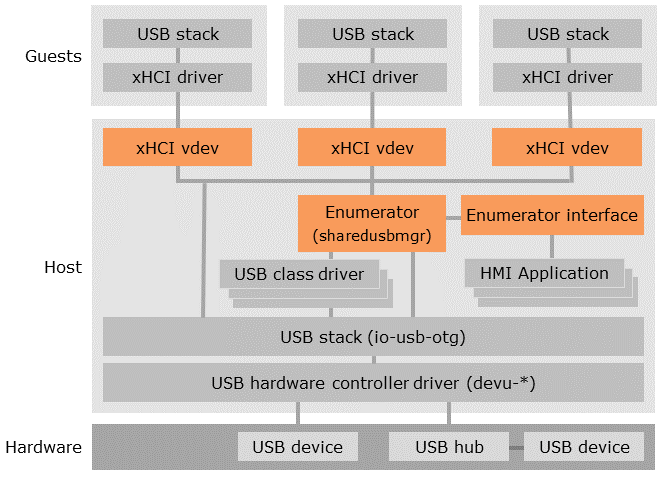The Shared USB framework enables guests running in virtual machines (VMs)
to access USB devices connected to a QNX Hypervisor host.
The framework provides a USB virtual device (vdev) that emulates a host controller interface
and allows guests to access USB devices.
An enumerator service is also required, to perform guest and USB device discovery
and to expose an interface that allows host applications to monitor and respond to device
insertions and removals. We provide an example of an enumerator but you can write your own.
Note:
This chapter assumes that you are already familiar with the concepts presented in
the following documentation:
USB device sharing
The hypervisor host manages all interactions between guests and USB devices, as follows:
- The host owns the USB devices and runs drivers for those devices.
- The host also runs an enumerator service, which provides host applications with a
means of accessing the devices, and a USB stack, which is a server that manages the USB
bus, USB protocols, and drivers for the connected devices.
-
If the guest in a VM requires access to USB devices, the VM presents a vdev,
exhci, to the guest. This vdev complies with the
eXtensible Host Controller Interface (xHCI) specification. Consequently,
the guest can run xHCI drivers to interact with the vdev.
These drivers are managed by the guest's USB stack. For information about setting up
USB and running the necessary device drivers on the guest, see your guest OS
documentation.
The diagram below illustrates the components involved in interactions between guests and
USB devices, managed by the hypervisor host.
 Figure 1. Shared USB framework architecture
Figure 1. Shared USB framework architecture
Note: For more information on device sharing in the
QNX Hypervisor, see
the section on
“Devices” in the
“Understanding QNX Virtual Environments”
chapter of the QNX Hypervisor
User's Guide.
Handling of device insertions and removals
The USB framework differs from other shared frameworks because the xHCI vdev must respond dynamically to
device insertions and removals.
Other frameworks provide guests with access to shared resources that either are always present on the host system (e.g., the VPU)
or allow the guest to access data whenever it's available, without having to know if the device is still physically connected
(e.g., sensors, cameras).
But USB devices can be added or removed at any time, and the vdev must respond in turn.
The USB stack is the service that detects whenever a device is inserted or removed, and it notifies the enumerator in both cases.
When the enumerator learns of a device insertion, it publishes information about the device through the
Persistent Publish/Subscribe (PPS) service.
A privileged application, such as the main HMI process, that's subscribed to the appropriate PPS objects
can respond to device insertions. For instance, the HMI process can learn that a USB stick has been inserted and ask the user
a question such as “Play music on new device?”. If the user says yes, the HMI process informs the enumerator through PPS.
If the HMI input information indicates that the device belongs to the host,
the enumerator launches the necessary class- or function-specific device driver
(e.g., devb-ustor for mass storage devices).
If the device belongs to the guest system, the enumerator sends a command to the
vdev that tells it to attach to the device via the USB stack. This device can then be used by guest applications.
If the user chooses to detach a device through the HMI process, this process informs the enumerator.
When the enumerator receives this notice through its PPS interface, it stops the associated device driver, removes the device
information from PPS, and if the device belongs to the guest system, the enumerator sends the vdev a command telling it to detach
from the device.
The vdev also monitors the stack for device removals (but not insertions), so it can handle the case when a device is physically
disconnected. When this happens, the vdev detaches from this device, which is then no longer accessible to guest applications.
This design means the vdev interacts directly with both the enumerator and the USB stack, for different purposes.
Because the enumerator also receives notice when a device is disconnected, it can respond by removing the device
information from PPS.
